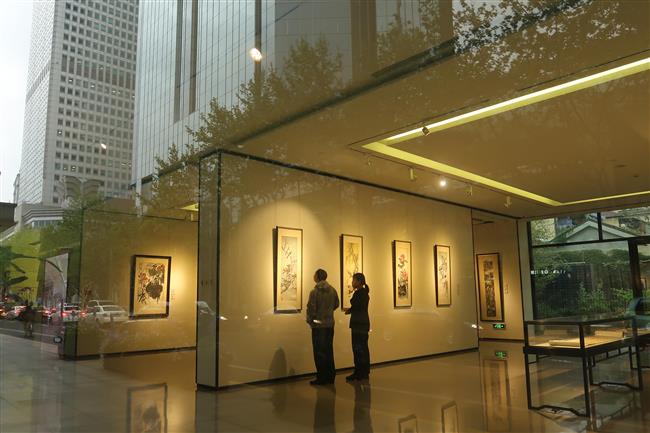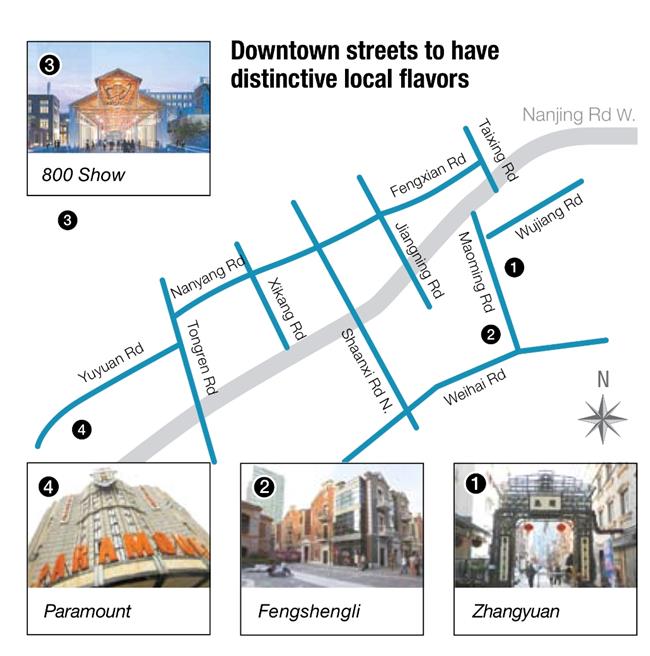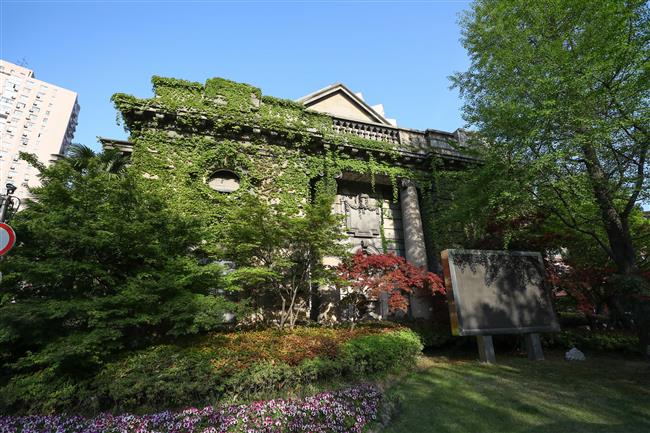
Fengshengli hosts vintage buildings with trendy eateries. It’s a popular hangout in Shanghai.
 Wang Rongjiang / SHINE
Wang Rongjiang / SHINEArt gallery on the Tongren Road
Small alleyways off main avenues are usually stereotyped as boring, cluttered with the same old shops. Jing’an is out to change that concept.
This month, the district government released detailed plans to spruce up 11 backstreets that feed into bustling Nanjing Road W. Distinctive features for every one of them will be based on location, history and individual culture.
Jing’an has been working for years to turn Nanjing Road W. into the equivalent of the Champs-Elysees in Paris, Fifth Avenue in New York or Oxford Street in London.
Today, the main drag has matured into that dream. It’s now time to develop backstreets, said District Director Lu Xiaodong.
He said Nanjing Road W. is so successful that it is well able to support a more dynamic environment on its periphery.
Backstreets are part of the city’s cultural DNA and an epitome of urban society and culture, according to Charles-Edouard Bouee, chief executive of German consulting firm Roland Berger, which helped the district draw up the Jing’an blueprint.
The backstreets will offer multiple experiences, create people-oriented public spaces and pioneer new retail concepts that echo global trends in urban development, said Jiang Hao, vice president of the firm’s China office.
He added: “They will not be the same old, same old. Instead, they will feature the aspects of a desirable lifestyle.”
The layout of “three belts, three Axes, two streets” is the backbone of backstreet redevelopment.
 SHINE
SHINEThe “three belts” link Yuyuan and Nanyang roads and adjoining Fengxian Road with Wujiang Road, from west to east.
Yuyuan Road contains the former residences of famous people, traditional alleyway houses and garden villas. It will be renovated as a community of exquisite lifestyle, with dessert bars, book cafes and workshops conducting classes in painting, flower arrangement and the tea ceremony. Sculptures will be erected in public spaces.
Nanyang and Fengxian roads sit behind the established shopping malls of Westgate Mall, CITIC Square and Plaza 66. This section will feature a scene that is young and trendy, with boutique shops, designer brands, vintage stores and popular eateries. Cherry trees will be planted along the roadside, enhanced by special-effects lighting.
Wujiang Road, known as a food street, will embrace the latest retail trends by introducing self-service stores, pop-up stores and other crossover projects. It will feature innovative landscaping, including green roofs and graffiti on facades.
Shaanxi Road North, Jiangning Road and Tongren Road form the “three axes” in the blueprint. Shaanxi Road will be home to local time-honored brands like Longfeng cheongsam. Haute couture stores, exhibition centers and workshops for visitors to view traditional Shanghai experience skills will round out the roadway. Heritage-listed buildings make the area ideal for strolls through history.
 Jiang Xiaowei / SHINE
Jiang Xiaowei / SHINEThe Ohel Rachel Synagogue on Shaanxi Road N. is a legacy of the 1930s, when Jewish refuges settled here to escape the Nazis in Europe.
 Jiang Xiaowei / SHINE
Jiang Xiaowei / SHINEThe immersive theater of McKinnon Hotel
Jiangning Road, home to the historic Majestic Theater, the modern Yihai Theater and popular immersive theater McKinnon Hotel, will be redeveloped to rival New York’s Broadway or London’s West End.
Tongren Road, opposite the Jing’an Kerry Center, is set to be the home of high-end galleries, museums and auction houses. The “two streets” in the redevelopment plan are Weihai and Xikang roads.
Weihai Road is home to local media giants like the Shanghai United Media Group and Shanghai Media Group, and to emerging industrial players such as co-working space pioneer WeWork. The street will be redeveloped as an incubator for digital media.
Xikang Road will be an international sports neighborhood, with the Jing’an Gymnasium, 24-hour self-service gyms, sports retailers and healthy-diet restaurants.
Taixing Road and Maoming Road North are designated as popular nightlife areas, with entertainment venues like Zhangyuan 99 and Fengshengli -- two popular hangouts for expats. Additional bars and restaurants serving international cuisine will be introduced.
Another two landmarks in the area are the legendary Paramount ballroom, cradle of Shanghai jazz, and the 800 Show, where Shanghai Fashion Week is held.
 Wang Rongjiang / SHINE
Wang Rongjiang / SHINEZhangyuan 99
Taking cue from abroad
In developing a blueprint for the Nanjing Road W. backstreets, Roland Berger studied examples of other world-class shopping districts.
For example, the backstreets of London’s Oxford Street offer shopping and entertainment in terms of book stores, theaters and food.
Shaftesbury Avenue, with 49 theaters, forms a world-class theater hub. Some 75 percent of Londoners put the area on their must-go-to lists, according to one survey.
Charing Cross Road is renowned for its specialist and second-hand bookshops, including the famous Foyles bookstore.
Savile Row, famed for traditional bespoke tailoring for men, is where the spy film “Kingsman” was filmed.
In Tokyo, tucked away in the crowded Ginza shopping area, are many venerated retailers. Visitors can try on traditional kimonos and experience the tea ceremony in Japanese-style rooms.
The area also has more than 100 art galleries, museums and artists’ workshops. It is designed to immerse visitors in traditional Japanese culture.
In New York, the area surrounding Fifth Avenue in New York is home to more than 500 technology startups, creating a neighborhood often called “Silicon Alley.” Incentives such as tax deductions have attracted co-working spaces and start-up incubators.
